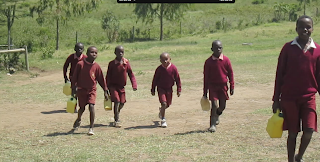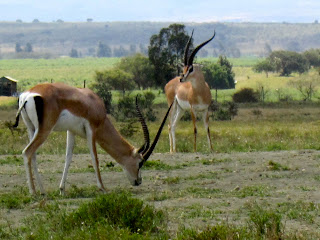We are currently using the Better Water Maker with a few different groups of people. Our goal is to help provide it to those who it will impact the most. Schools, hospitals, and youth groups are our biggest groups. The BWM can be powered by a hand crank (much like bicycle pedals for your hands), a car battery, or by electricity. We have to take this information into consideration as we place the pumps and as we help the organizations create plans for their use.
We are currently working with three schools on the use of the BWM. Kimbo School and Ngumo School have had the BWM for a few months. Kimbo School does not have electricity. Most of their classrooms are built from mud and sticks/wood, except for one building that was built by sponsors. The kids here often drink water from the Malewa River, which is close to the school. Kimbo has found ways to have students use the hand crank to pump the water during their breaks. This seems to be working fairly well for them, though we know it does not process enough water for the entire school. They are very grateful for the BWM.
Kimbo Primary School
 |
| Everyone watches while we test the water. |
 |
| John is using the hand crank to purify water |
 |
| Love these faces at Kimbo Primary school! |
 |
| Tires are toys for these kids. They roll them down the hills! |
 |
| These kids were happy to get containers of water from the Malewa River for our testing. Click on the following video clip to watch the kids testing the water. Everyone is eager to help! |
Ngumo Primary and Secondary School
Ngumo is a larger school, with somewhere near 600 students. They actually have a primary and secondary school in the same location. They also do not have electricity and must use the hand crank for the BWM. They’ve had some more difficulty with its use, as it is difficult to find time within their day for the older kids to pump the water, particularly because it is exam time. They have also experienced situations in which the older students have been taking the purified water from the younger students in the school. We’ve tried to work with Ngumo to create a plan for a club to purify the water, and for the purchase of a car battery to run the BWM. This way, the BWM could be located closer to the younger students, who are at higher risk for dysentery and other diseases from contaminated water. Their students, however, have demonstrated the use of the BWM with ease at this school.
 |
| Kids get the camera! |
Click on the video below to watch the Ngumo students pumping water with the hand crank.
Mwega Primary School
Mwega School is our newest school to receive the pump. This school is located close to where I live and to the office. The school was previously provided donations by a group in the UK, but apparently, there was some mismanagement at the school and the group withdrew their support. Mwega now has a wonderful new principal and has been very excited to learn about and accept the BWM. In fact, we have already provided two training sessions to the students in their after-school Boy Scouts and Girl Guides clubs. The principal and clubs teacher, as well as their deputy, all stayed for the demonstrations to learn more. After the kids tested the BWM with the hand crank (they hope to have electricity within the year), they all thanked us for the BWM and celebrated. I look forward to seeing the progress of this school with the BWM.
Click on the video below to watch the Mwega students pumping water with the hand crank.
Gilgil Hospital
Gilgil Hospital is the location of another Better Water Maker. At this hospital, a youth group runs the BWM every other day in the hospital and provides purified water to various wards. Can you imagine- a hospital still in need of a means to purify water!?! The group also brings the BWM out into the community to provide clean drinking water to those they can. The group has electricity in the hospital and tries to find places in the community that have it as well.
Karunga Youth Group
Karunga Youth Group is also working with a BWM. This group of young adults gathers regularly to play games and activities, and to provide assistance to the Karunga Health Center. We have met with them several times for demonstrations and planning meetings. The group is purchasing the BWM from us (the small fee for some of these organizations is shown to produce better results, as the group contributes to their mission with funding), and may use it in town to sell clean water, as well as at the health clinic to provide volunteer assistance to the doctors and nurses.
Gatundu Youth Group
Gatundu Youth Group has had the BWM for several months. They are in the process of gaining a permit to sell the purified water from a kiosk in town. I have struggled a bit with this group because every time we go to check on the BWM with them, we have to drive around town looking for new people. Their idea for its use is good, and we are working to try to support its implementation. Many people in town could benefit from the use of the BWM in their kiosk.
Gitare Youth Group
We also met with a youth group called Gitare. They don’t have a plan yet, but they work near a large natural dam that people use for drinking water. We hope they may have a plan in the near future for the BWM. The facilitator of the group gave us a tour of the dam and surroundings. They were beautiful, but it was here that I learned of Safari Ants- not a particularly wonderful situation when you have little creatures quickly crawling up the legs of your pants and biting you along the way. Having “ants in your pants” became a reality for me here in Gitare!
Utwtu Eco-Tourism Center
Utwtu Eco-Tourism center (mentioned in another blog) is also interested in the BWM, yet we don’t think it can provide the amount of water they need. We’re also working with a group called PureFlow that wants to purchase the BWM to support their other efforts with producing clean water.
Well, I think that sufficiently covers the BWM work!
































